Project Background
For my final project I knew that I wanted to do something with arrows. I learned how to shoot a bow with my grandfather when I was a child, and since then archery has become a favorite pastime of mine. For the upcycling project I considered using some old broken arrows as a material, but decided the end product wouldn’t fit with the aesthetic I was looking for in the project. While this ended up being the better choice, the problem was that I still had a pile of old arrows sitting around with no purpose.
A couple weeks later I was making arrows over the weekend which required cutting arrows to a specific length. After finishing the arrows I had a pile of ends sitting on the table and suddenly saw the arrows in a new light. When looking down the end of the arrows I discovered that the open ended tubes had a cool visual effect. It was from this instance that a vision for the project was born.
From there I started to look up different pieces of pipe art work (closest things to arrow tubes that I could find) on the internet and came up with some cool projects that had previously been done as can been seen below.
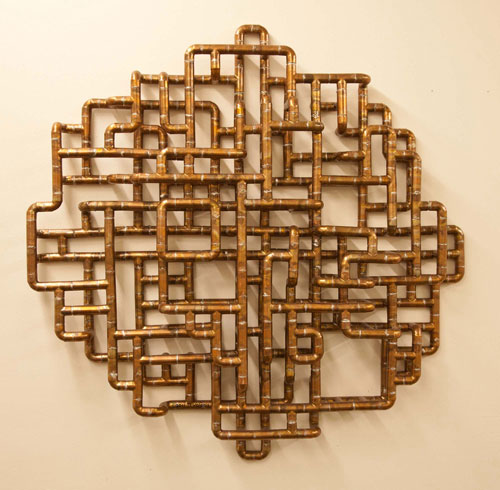

http://www.motherearthliving.com/green-homes/heavy-metal.aspx
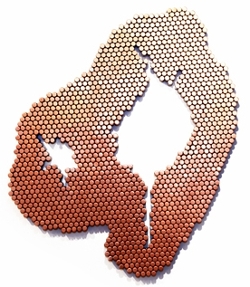
http://www.copper.org/consumers/arts/2014/august/tj-volonis.html
The last picture shown above was the one that finally caught my eye. I thought that I could do a similar design with the arrow shafts as well as cut the shafts to different lengths to get more of a 3D effect rather than the flat appearance in the piece shown above..
As for the dynamic component, I discovered that an LED fits perfectly within the arrow shaft. Thus for the dynamic feature I thought that is would be cool to mount some LEDs within the shafts and create different light patterns.
Project Concept
Conceptualizing my idea further I decided I wanted to create a piece of art that that had arrow shafts encased in an acrylics box with LEDs on the end of the shaft to light up the inside of the tubes. The color of these LEDs would be controlled by an external remote making the piece personalized for each user. The arrows would be placed in a varying patterns in the X, Y, and Z directions in order to give a patterned appearance and to change one’s perspective on the piece depending on the angle that they view it from. Functionally, this ended breaking down the project into 3 components, the LED lighting system, the arrows themselves, and the acrylic box to hold everything together.
Milestones
Preliminary Design Review: 3/2/16
Critical Part Arrives: 3/8/2016
Critical Part Tested: 3/14/16
CAD Design Finished: 3/18/16
Assembly: 3/25/16 – 4/11/16
Final Presentation: 4/25/16-4/29/16
First Impression
My biggest goal when developing this project was to create a piece that could not only change with time, but would look different depending on what angle you were observing it from. For example, when viewed straight on, the LEDs are the main component that are seen, but when looking at the piece from the side a wave-like shape can be seen. Additionally, I wanted the piece to be able to grab someone’s attention. I want the end user to come over to the piece and play with the controller and watch how the part changes with changing color patterns.
Function
Similar to the first impression section, the function of this project was to be able to create a piece that people go up to and play with. The piece thus needed to be robust and secure so that users were not afraid to touch it or view it.
Aesthetic:
For the design aesthetic of the piece, the end product is somewhat of a mix/contrast between the organic design movement and the high tech movement. The circular tubes, the color scheme, and waves in both the Y and Z direction of the tubes lead the design towards an organic feel and can have an almost calming effect. However, the brightness of the lights and the black, shiny color of the acrylic steer it more towards high tech. Combined I think that this leads to an interesting contrast for an end product.
Constraints
For this project, there were 5 major constraints considered in the design process.
- Cost: As a college student with no substantial income, the cost is a large constraint on this project. I would like to keep the cost below $100 if possible for the project. I plan to do this by taking the extra time to find the material I need at a discounted price. For example, the arrow pieces are free to me, and the acrylic will be purchased from the discount pile a Mcguckin’s.
- Current: The current allotment for the LED light strand is also a large constraint on this project. The bigger the piece that I try to create, the more LEDs that I will need which results in more current needed to complete the project. Luckily, the strand uses a power source with a barrel jack connector on it which is a pretty common electronics connector. This means that if I need more LEDs I can purchase a variety of power supplies with different current rating to meet the current specs.
- Arrow Supply: I have a limited amount of arrow tubing that I have access to for the piece because of my intention to use scrape arrows. This will dictate how many sections of tubing I have as well as what length they can be.
- Time: This project is constrained by the fact that it needs to be completed by the end of the semester which makes time a very large constraint. While there are many cool things I could do for this project, I have to make sure that the final design is within a scope such that it can be completed by the end of the semester.
- LED Spacing: The light strand that I chose for my final design has a predefined spacing between LEDs. This will constrain how I can space the arrows on the piece. Additionally, the LED strip comes in a 3 LED segment meaning that, in the design, I want to try to keep straight lines at a length of a multiple of 3 in order to not waste any LEDs.
Design Iterations
As previously stated, functionally the project has three main components: LED lighting system, the arrows themselves, and the acrylic box to hold everything together. By figuring out how all of these parts come together, the design went through a couple different iterations in order to achieve a final product.
LED Lighting System
After explore a couple different avenues and looking at a number of data sheet I decided to use the RGB LED strand seen below.

http://www.amazon.com/gp/product/B00CE580B0?psc=1&redirect=true&ref_=oh_aui_detailpage_o00_s00
An advantage to using this lighting system is that the product comes with a power supply, control panel, and the connections needed to light up the strip. I still needed to cut and re-solder the strips to create the desired pattern, but it was a good place to start from. The system I purchased has a wireless controller with over 20 color options which should provide a good interactive element to the project.
Unfortunately, cutting and rebuilding the LED strip ended up being a lot more tedious than I initially anticipated as the solder did not want to cooperate and there was a lot more soldering that needed to be done that I initially anticipated. For each two strands of LEDs that needed to be connected I ended up having to cut 4 different length wires and individually solder them to each strand to create a flat curve of wires. It took a while, but in the end a functional LED array was able to come together. Pictures documenting this process can be seen below.

Soldering LED Strip Ends
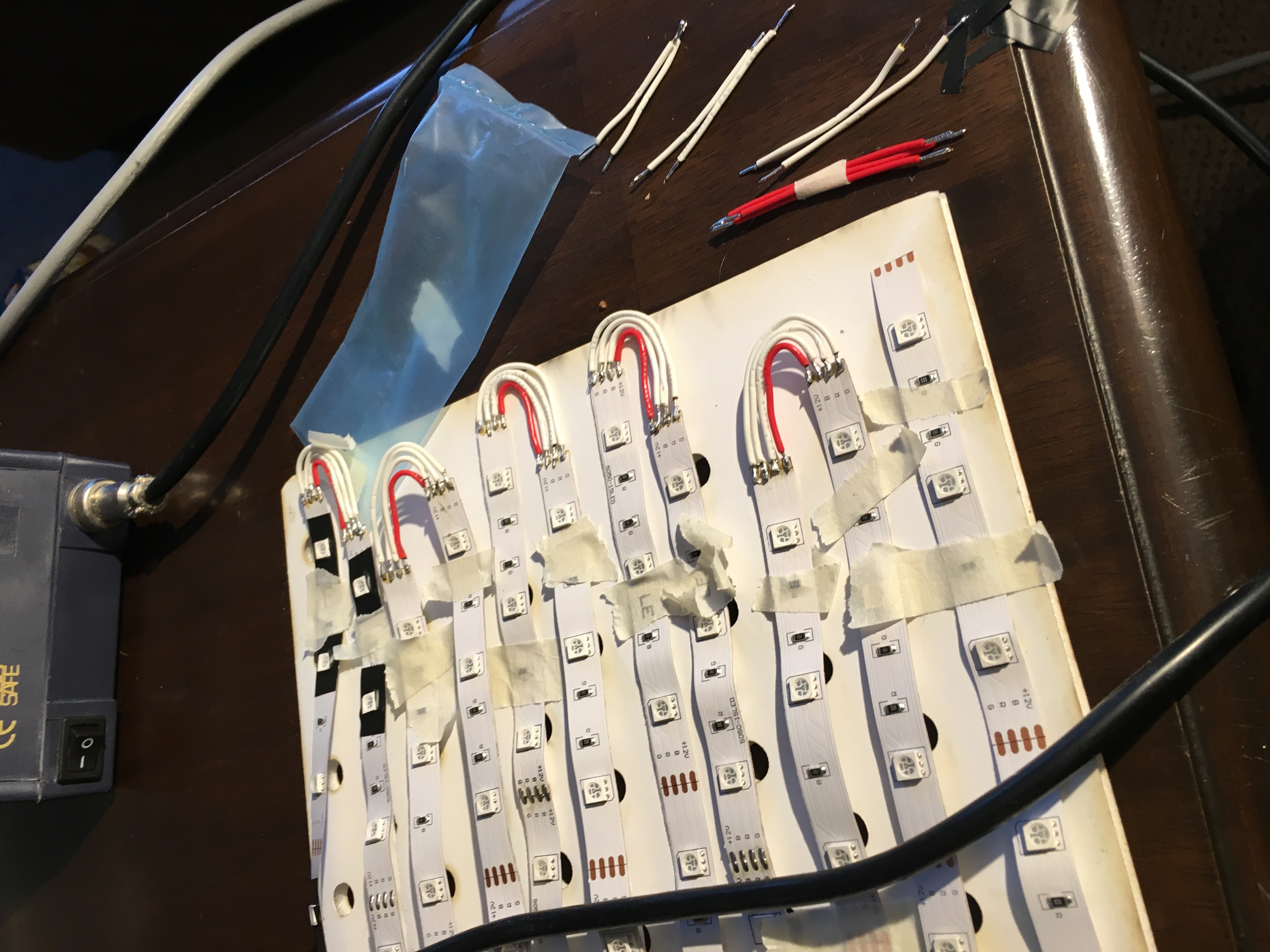
Complete Wiring

Lit LED Strip Post Soldering
Arrows
For the arrow pattern of the design, I ended up going through a couple different iterations due to the constraints presented by the way in which the LED strip was constructed. I always wanted to create a wave pattern in the Z direction of the tubing, but the 2D pattern that the arrows took were an unknown for awhile.
For my initial idea I came up with a honeycomb pattern with arrows cut to different heights. A rough CAD model can be seen below.
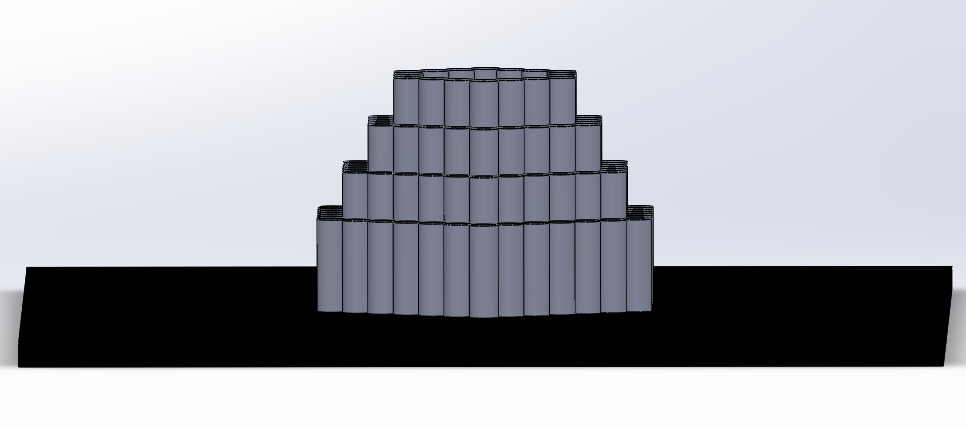
Initial Idea – Side View
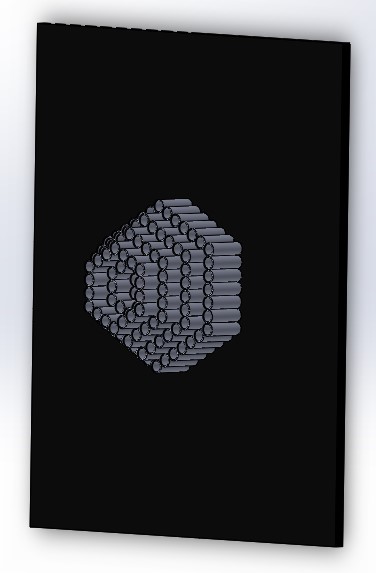
Initial Idea – Top View
This gave an appearance similar to a volcano with the potential for some cool color patterning through the different rings. However, the pattern of the arrow layout design changed once I started to play with the LED strip. I discovered that the LED strip had to be cut in 3 light segments in order to easily be rewired (this is where the soldering patches are located on the strip). The problem with my previous design was that I had line segments that were either longer or shorter than a multiple of 3. As a result, I had to redefine the pattern so that it had 11 segments of 12 LEDs. I arranged the arrows to now have a wave pattern that is offset on each row (see pictures Below). For this new design I tried to be conscious of geometric aesthetics such as translational repetition and symmetry like we talked about in class.
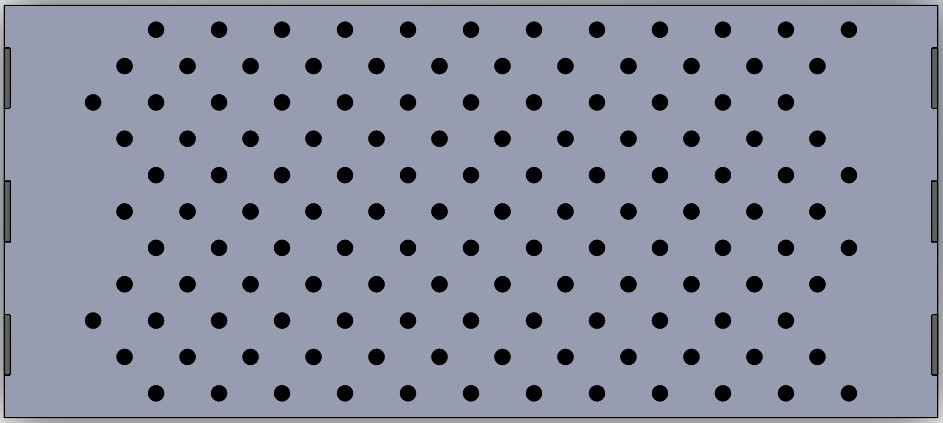
Iterated Design – Top View

Iterated Design – Side View
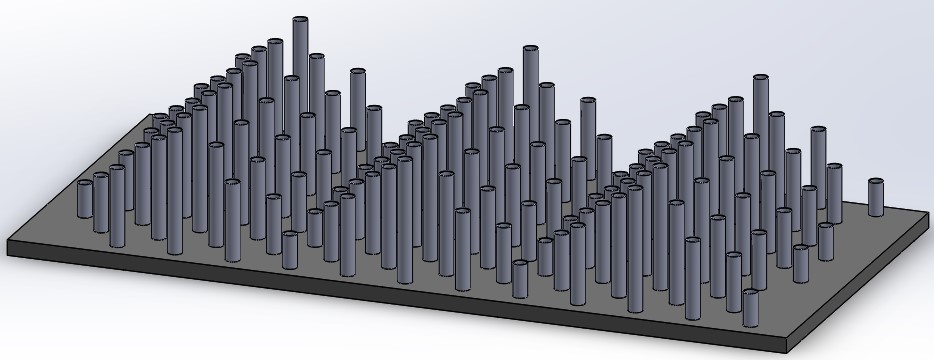
Iterated Design – Iso View
Once I had finished designing the piece in SolidWorks, it was time to start pulling supplies together. After sorting out the old arrows by size I had to take the fletching off of the ends in order to create just tubes.
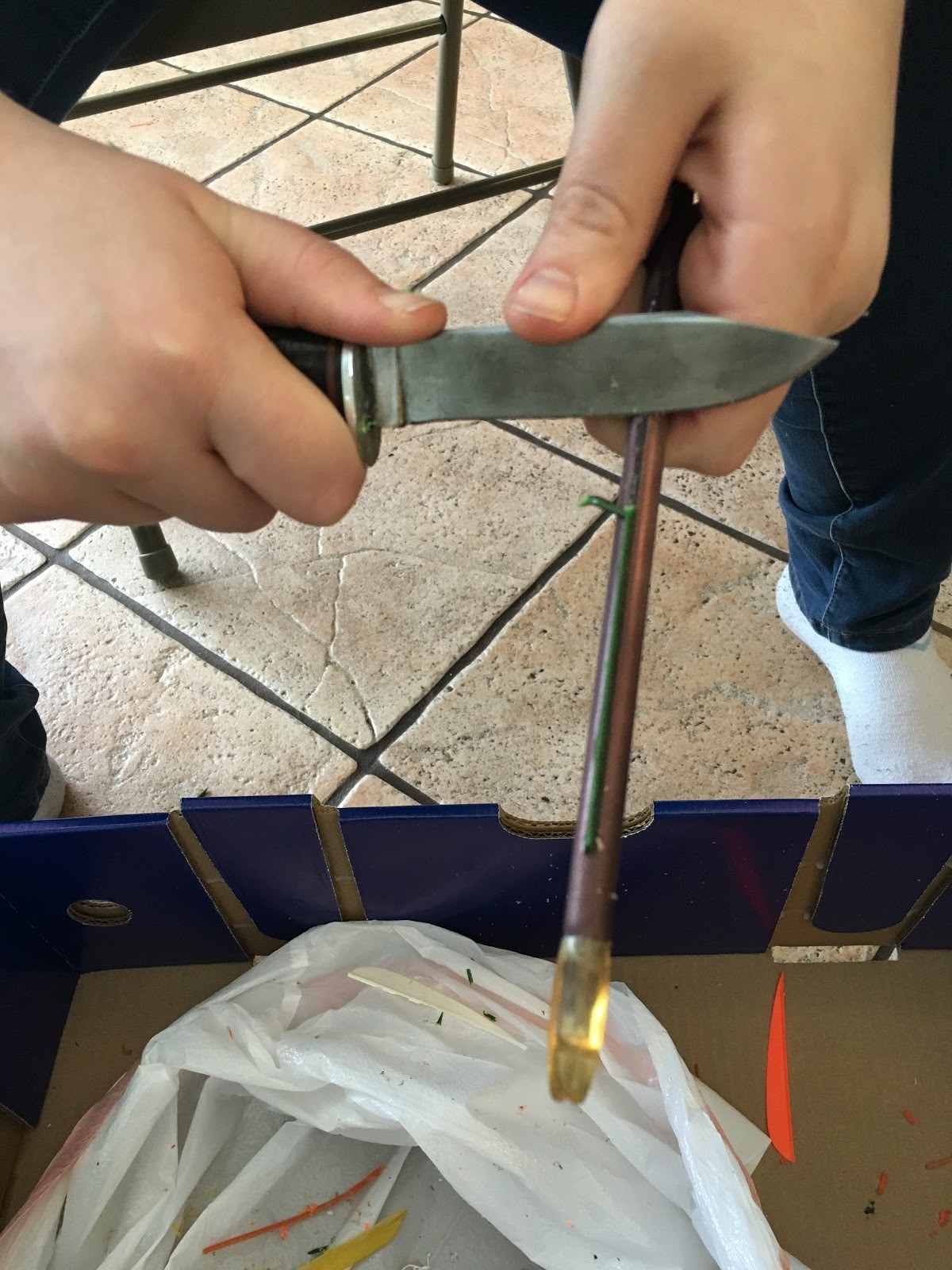
Removal of Old Fletching From the Arrows
After finishing the CAD model I knew what length I needed to cut the arrows and how many of each length I needed. With that, I began to cut. It was a long and tedious process, but I finally got all of them cut (approx. 130 tubes). I then created a box out of foamcore and cardboard to get a visualization of the final product in real life.

All of the Arrows Cut to Length
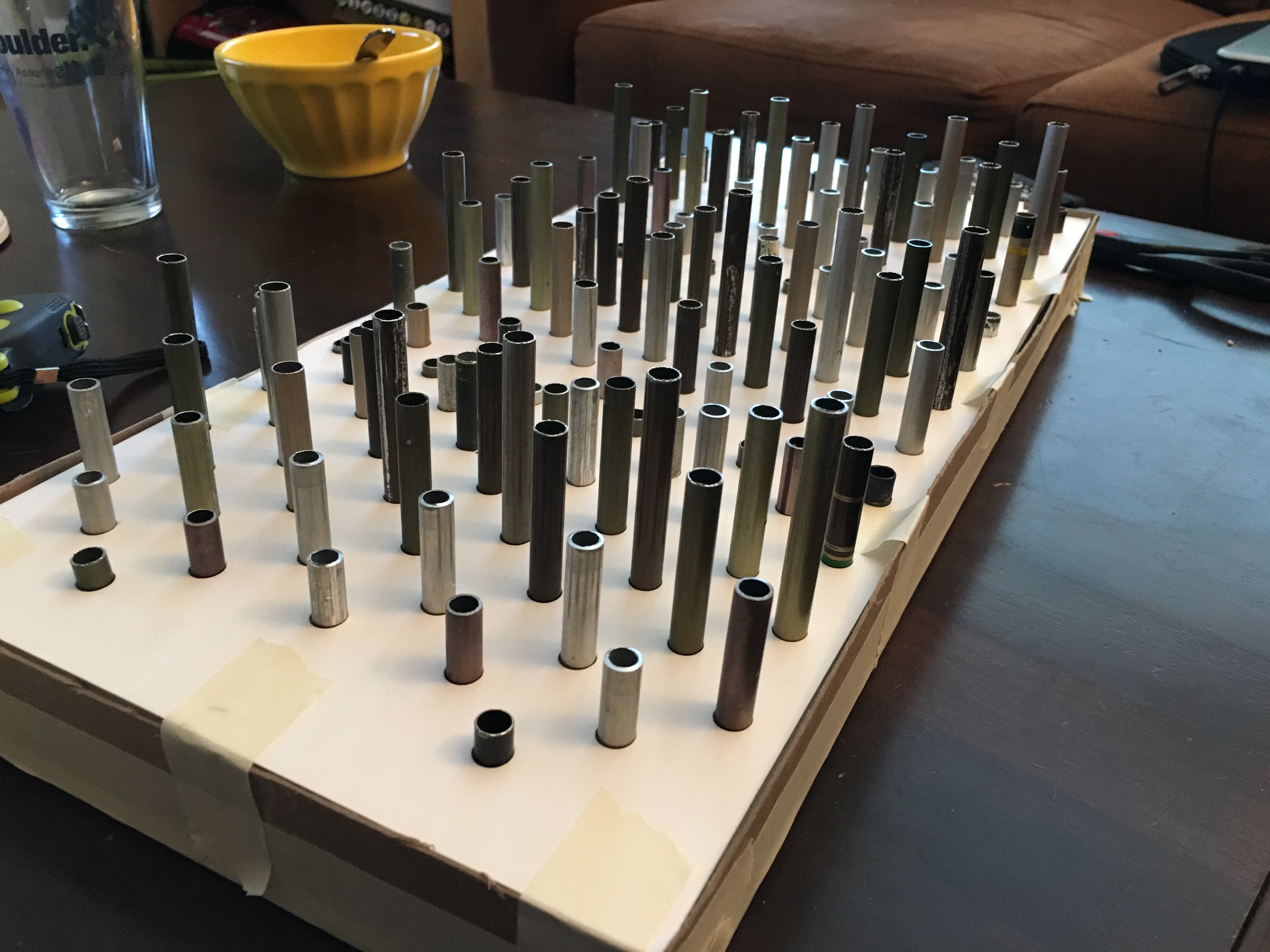
Arrows Arranged in New Layout Design
As seen in the picture, looking at the piece from different angles gives it a different appearance even without any lighting. Overall I was very happy with the results thus far.
Acrylic Box
Once the LED strip was completed, I decided to cut out the base design I had created out of foamcore to make sure everything would fit, and then attached the LED strip and arrows to see how it was all fitting together. The results can be seen below.

Laser Cutting the Base

Everything Together for the Final Prototype
The LED lighting ended up working better than I anticipated and gave a cool effect when looking at it from the side. The prototype was not perfect as it was too hard to get all of the LEDs to align right underneath the tubes.This issue was addressed in the final design by engraving a guide as to where to place the LED strip on the bottom plate.
Bill of Materials
In the end, this project ended up being rather cost effective. The major cost ended up being the LED strip, but everything else was able to be gathered for free from the ITLL or was purchased at a discounted price such as the acrylic. All in all the major cost of the project ended up being the amount of hours put in to create all of the parts. This totaled to roughly 28 hours not including all of the time spent prototyping the piece.
|
Item |
Material | Cost | Manufacturing Process | Hours |
|
Arrows |
Aluminum Alloy | Free | Strip, Cut, File | 8 |
|
LED Strip |
Electronics | $18.99 | Cut and Solder | 7 |
|
Acrylic Base |
Acrylic | $3.00 | Laser Cutter |
4 |
|
Wires and Solder |
Electronics | Free | N/A |
3 |
|
Epoxy |
Adhesive | Free | N/A |
3 |
|
Acrylic Cement |
Adhesive | Free | N/A |
3 |
|
TOTAL |
$21.99 |
28 |
Final Design
After completing the last prototype, there was not much more required to get the final design created and completed. Taking some of the fit issues I found in the prototyped designs, I finalized the CAD for the acrylic box such that it would all fit together with space for the electronics underneath. CAD images of the final design can be seen below.

Final Acrylic Box Design
![]()
Final Acrylic Box Design – Side View

Final Acrylic Box Design – Inside View
As evident in these pictures, the final design for the acrylic box had a construction that was very intentional such that the pieces would all fit together and support each other. This was accomplished by adding teeth on the edges which would fit together and were then glued together to create one singular piece. A middle plate was added to help with the stability of the arrows and to keep them vertical when mounted into the the box. Additionally, a cutout was added to house the control box and cord to keep the electronics as contained as possible.
For the final design I added an engraved box to the bottom plate which acted as a footprint and helped me to align the LED strips more evenly underneath the arrows. I then constructed the box, put the arrows in place, and glued everything together with acrylic cement and epoxy in order to create one robust part. I left the back plate detachable so that I would be able to get to the electronics underneath in case something went wrong. The final design can be seen below.

Final Design Sitting Flat

Final Design Sitting Flat – Side View
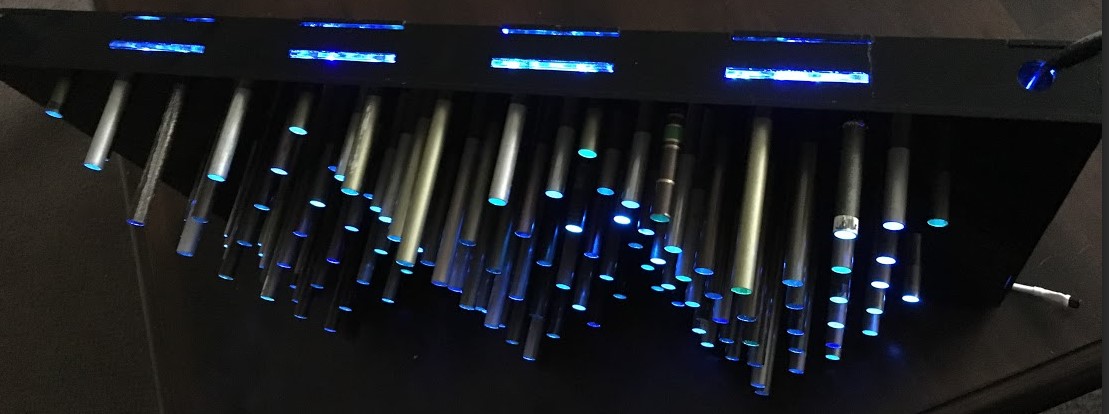
Final Design Sitting on Side – Top View
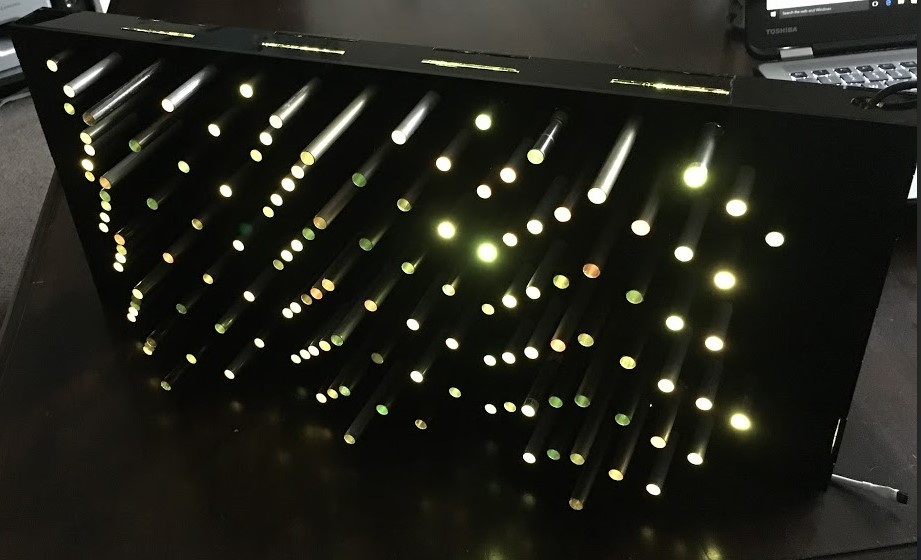
Final Design Sitting on Side
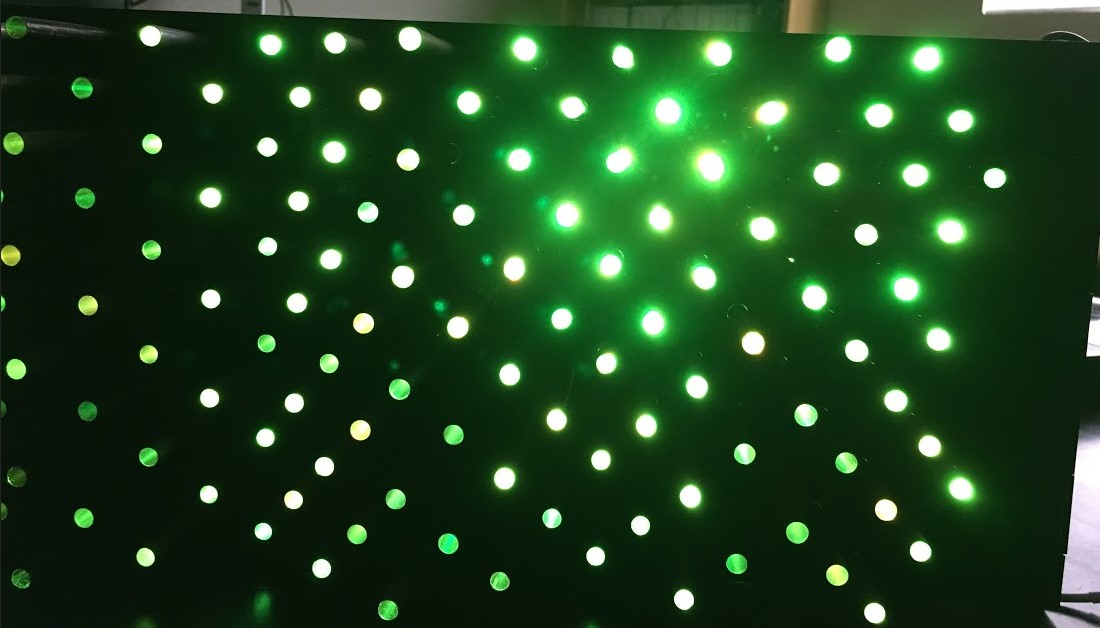
Final Design Viewed Straight on
The end result turned out a lot better than I could have imagined. The different lengths of arrows changed the way the light traveled through the tube giving the appearance of a spectrum of color. Additionally, the slight difference in each individual tube made the color coming through change from arrows which had similar heights. The result was a unique looking pattern of light even though the same color was being emitted from each RGB LED.
In playing around with the different orientations of the piece I discovered that while having the piece lay flat on the table worked well, viewers were able to get a more dynamic look at the piece as they moved around if the piece of art was sitting on it’s side. However, mounting on the wall per the original intent did not work well because the LEDs were blinding if viewed from eye level and resulted in a loss of ability to view the piece of art. Thus I ultimately decided to have the orientation of the piece be one where it sits on the side so that the viewer still have both the sideways and overhead view of the piece.
By turning the piece on it’s side another cool feature became evident in the light shining through the middle plate of the piece. I had created the middle plate out of clear acrylic which fit into the box through slots in the side panels. When the box was all glued together it left a clear and open slit on the sides. Once the LEDs are lit up the slots suddenly become bright and the viewer can actually see the arrow shafts mounted inside of the box. This again gives a different view on the piece than initially intended and adds to the dynamic viewing experience of the user.
All in all the the final design for the piece turned out very well. By being meticulous and iterating each component of the design I was able to create a final product that not only met the need, but created a product far better than any that was initially thought of.

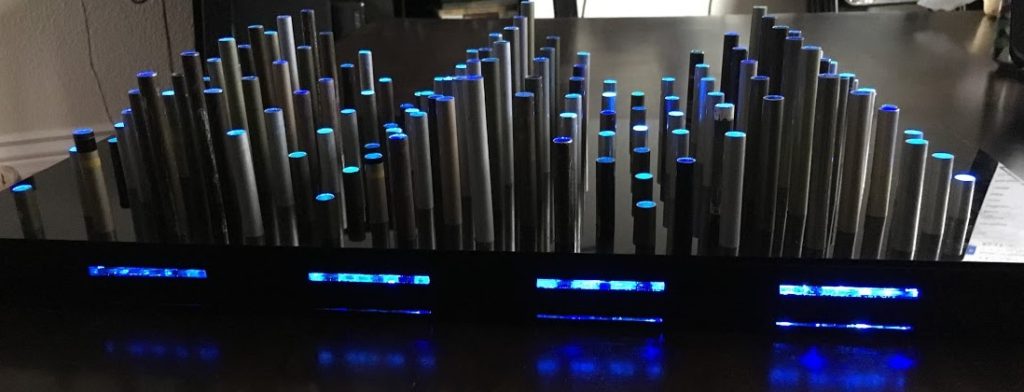
8 Comments. Leave new
This is a really beautiful thing you’ve made. I wonder if it would be possible to mount it on the ceiling to use as an overhead lighting accent piece? Or would that cause problems?
Great job Sami. It took a lot of effort to get this project this nice and polished. Once you pointed out that it looks different from various angles I was sold. You should be really proud of this project. I hope your grandpa enjoys it.
I absolutely loved how your project turned out! The best part was looking at it from different angles. It was mesmerizing to see the different colors and the slight shifts just based on how the light was reflecting in the shafts. I was also very impressed with how clean the final product looked! Many people set out to create clean pieces of art, but you definitely succeeded in creating a modern and beautiful piece! It would be super cool to expand this piece or have a set of several of them wall mounted to create an immersive experience.
I also left a longer comment, but for your presentation I just want to comment on how mesmerizing it is to watch the colors change. This is for sure one of my favorite projects in the class. =)
Sami, this turned out unbelievably great. You can tell how much work and effort you put into it. Your grandfather is going to be stoked when you give this to him. This project really came from the heart. I love the changing light patterns with the LEDs and the little cut outs on the sides of the base add another layer to the beauty and complexity/sophistication of the aesthetic. Your combination of modern art and engineering is inspiring.
This looks amazing, and I had a really fun time playing with the remote, at the Design Expo, to change your LEDs colors. I didn’t know that this function was going to be a feature, so it definitely a plus to your project. I liked learning about the aluminum arrow tubing I did not know they stopped making those in the 80s or 90s, so that was some interesting background on your project. Overall the design looks extremely clean, well-put together, fits into your aesthetic of choice, and you put a lot of hardwork in to make it something that you would be proud to hang in your home.
Great Presentation!
This is such an amazing design! This actually gives me inspiration because I’ve been wanting to make a simulation of the night sky to put on my ceiling, but all of them are so expensive. This would be such a good idea to have locked onto your ceiling, and it would be really relaxing to look at. I am impressive how you did all the LED wiring and hid the wires. Did you have previous experience with this, or did you learn all the circuitry while doing this project? I am also curious how long it took you in total to do this project. Seems like it would take forever to strip all the coating off of the arrows. OVerall, wow!!! Great Job!